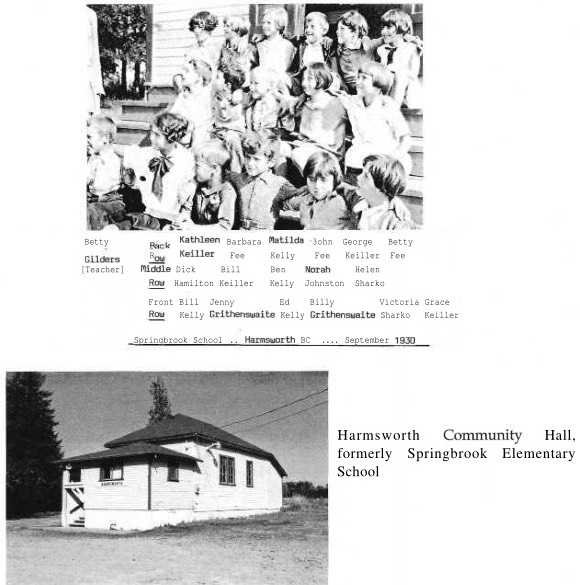(Information from John Fee [former pupil] and Norm Sherritt)
Springbrook School, located at the corner of Balfour Road (232) and Springbrook Road (72), was built in 1896 on land donated by Herb Titmus on the NW corner of his homestead. It was about one kilometre south of the BC Electric Railway which was built in 1910. According to Linton Harris, Jr., it was named after a sulphur spring at the corner of 72 and 232.
The school’s attendance (Grades 1 to 8) varied from 18-24 students and there was one teacher. However, in 1903, Lavinia Brown (nee Medd) attended at the age of 4, in order to maintain the enrolment at an acceptable level so that it could remain open.
The one-room creamed-coloured school had horizontal shiplap siding and a cottage-style roof. There were two outhouses. An artesian well on the south side of the property produced water with a very strong smell and taste of sulphur. The front doors opened into a narrow cloakroom which ran the full width of the school. There were also shelves to hold lunch buckets. There was a door at either end of the hallway to enter the school room. The school had oiled floors and a large stove in the centre of the room which burned cordwood brought in by the older boys. The room contained a teacher’s desk, the stove, and 5 rows of seats. The athletic field consisted of two horizontal bars and a couple of swings.
The younger children were in the rows against the south wall and the older children were on the north side of the room. When John Fee was in grade 2 or 3, he got the strap for looking at the big boys who were “raising hell”, after being told not to look. According to John, the teacher, Miss Annie Monroe, was a “miserable so-and-so” who unfortunately boarded at the Fee residence. John thinks his mother made it clear to Miss Monroe at suppertime that she was never to strap her children again. She didn’t, but only lasted one year at the school. John has a proficiency certificate signed by Miss A. C. L. Munro in June, 1930.
The school was one of only two buildings in the Harmsworth area, besides the station, which was not a farm building. Harmsworth extended from where the Salmon River crosses Balfour Road (just south of the Salmon River Hotel) north about 3 kilometres to the top of the hill leading down to the Salmon River Flats or Rawlinson Crescent. The hill was referred to as Potter’s Hill, because the Potter family lived on the west side of Balfour Road at the top of the hill. The road was gravel, with wooden milk stands in front of everyone’s farms, and mail boxes all on the right side of the road. Mr. Garnett delivered the mail, sitting on the right side of his Model T and reaching across to the brakes and gears with his left foot, a marvellous feat, according to the children.
The teachers that John Fee remembers from the 20s and early 30s were as follows: Miss McKay was a real “toughy” who left after several years in 1927; Miss Mabel Payne was a sweetheart (John was madly in love with her) who stayed from 1927 to 1929 when the three Fee children (John, Barbara, and Betty) attended; Miss Annie Monroe was a shock to the younger students, but only stayed one year; Miss Betty Gilders was a local girl who taught at the school until it closed in 1931.
When the school closed in December, 1931, the students were shipped by Harry Heller’s homemade school bus to Fort Langley, then to Milner, and eventually to Langley High School.
In July, 1934, the Harmsworth Social Improvement Society paid $175 for the Springbrook School and site. The building, which still stands today, was renamed the Harmsworth Community Hall. Renovations since 1934 include a new entrance and washrooms and a kitchen in the rear.
Springbrook School, as told by Vickie Jenkens (nee Sharko)
In the 1930s, Vickie lived in the Springbrook area where the freeway crosses 232 today. For awhile, the students from Springbrook had to bus to Fort Langley while awaiting placement at Sperling School. Vickie says she hated school and disliked the roundabout way of reaching Fort Langley School, especially when the road was flooded.
One day Vickie did not get on the school bus with the other children, but hid behind a stump. All day she sat there, ate her lunch, and then went home when the others returned after school. When she reached home, her mother asked her if she enjoyed her day behind the stump. Unknown to Vickie, her mother could see her hiding place all day. Her life as a truant was over.


